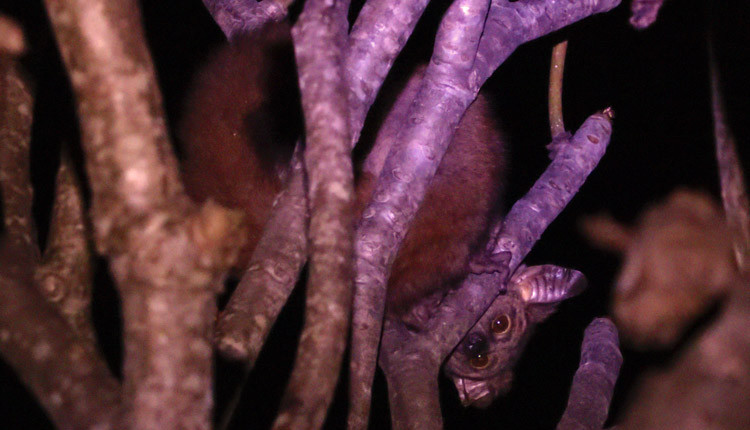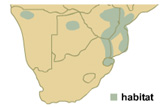Bush Baby in Kruger National Park
We spotted this cute little fellow last night in the tree behind our house in the Greater Kruger National Park Area. The Bush Babies or Galagos of Africa are of the smallest primates on the continent and are not easily seen due to being active at night.
They are more often heard than seen, with their baby-like cries in the African Bush. This little guy is called the Thick-tailed bush baby. The bush babies can be found within the rest camps in Kruger Park. All the little animals like owls, bush babies and others makes it a truly outdoors experience!
Behaviour
This is the most social of all known bush babies. This species, unlike other galagines, move through the forest and bush in groups of two to six. When this species jumps, it lands with hind limbs first. This species is active at night, with both male and female dispersing from the birth territory. Males will leave the nest earlier than females, so the number of males in a group differ in time. When it has to move on the ground in open spaces between the canopy, this species will land on their back legs first. They are active for an average of nine and a half hours a day during summer and twelve hours a day during the winter.
This species has a promiscuous mating system. The males travel further than females, which reduces the complications from inbreeding. Males and females have ranges that do not overlap with same-age individuals, but do share ranges with younger or older individuals. Males have home ranges that overlap more than one female.
Females are dominant in this species. Adult males were found to follow adult females more in captivity than females followed males. Social play in thick-tailed bush babies consists of exaggerated walk, chasing, tail pulling, wrestling, non-aggressive biting, and sudden jumpy movements. Infants play on the first day of life. Infants play more when they develop independence from their mothers during the fourth and fifth weeks of life.
They sleep in nests that are 5-12 meters off the ground. thick tailed bush babies sleep together during the day, but split up at night to forage. They have been found to move up to one kilometre through the night.
Thick-tailed bush babies urinate on their hands and also spread this on their feet. When they move around, they mark their territory which can lead to aggressive encounters or their will urinate as social grooming. This behaviour occurs more frequently in dominant individuals.
Apearance
The thick-tailed bushbaby is the largest of the Galago species. Their head and body length is between 29,7 to 37,3 cm, and tail length, from 4,15 to 4,73 cm. The body size of males is slightly larger than those of females.
The coloration of the fur is silvery brown to gray with the underside usually lighter. They often furl and unfurl their ears giving them a quizzical expression. The eyes are forward pointing and large. Their fingers and toes are much like our own with flat nails, making useful to hold on to trees.
Diet
Generally their diet includes insects, fruit, leaves, flowers, lizards, eggs and birds. Depending on where they live, the amount of insects they eat may differ in percentage of their total diet. A seasonal food includes the large termite. Thick-tailed bush babies have been observed eating them off the ground without using the hands.
Breeding
This species gives birth once a year, when vegetation is thick, although in captivity is was able to give birth all year. Nests are made in the tangles of vegetation. One infants is born on different days. Young are weaned at the beginning of the driest season. Infants become independent from their mothers between the fourth and fifth weeks of life. Both sexes reach maturity after 20 months.
Litter size is generally 2 individuals but can be 3. Females reach sexual maturity at 2 years. After birth, females will leave their young in the tree while they leave to forage. Anthropoid primates carry their young during lactation and the Thick-tailed Bush Baby in the Kruger National Park does not.
The birth season varies according to where they stay. It is restricted to November in the Gauteng and occurs in August and September in Zambia. Pregnancies peak in August in Zanzibar and Pemba. The female estrous cycle lasts approximately 44 days. Gestation is 133 days.
Habitat
Thick tailed bush babies are found in the countries of Somalia, Kenya, Tanzania, and on the islands of Zanzibar. This species lives in highland and coastal forests. This species also lives in riverine forests. The thick-tailed bushbaby, is found in East Africa from Southern Sudan to Eastern South Africa (especially the Kruger National Park) and through Southern Angola.




With over 500 birds recorded, Kruger National Park is a major birding hotspot. While you can tick off a lot of species on a morning or afternoon drive in the park, a stroll around one of the rest camps can be equally rewarding. The far north of the park (Pafuri and Punda Maria) is one of the country’s most highly rated birding areas with many regional rarities present. Eagles are particularly common in the park and the bateleur, with its distinctive shape, is almost a constant presence somewhere in the sky.